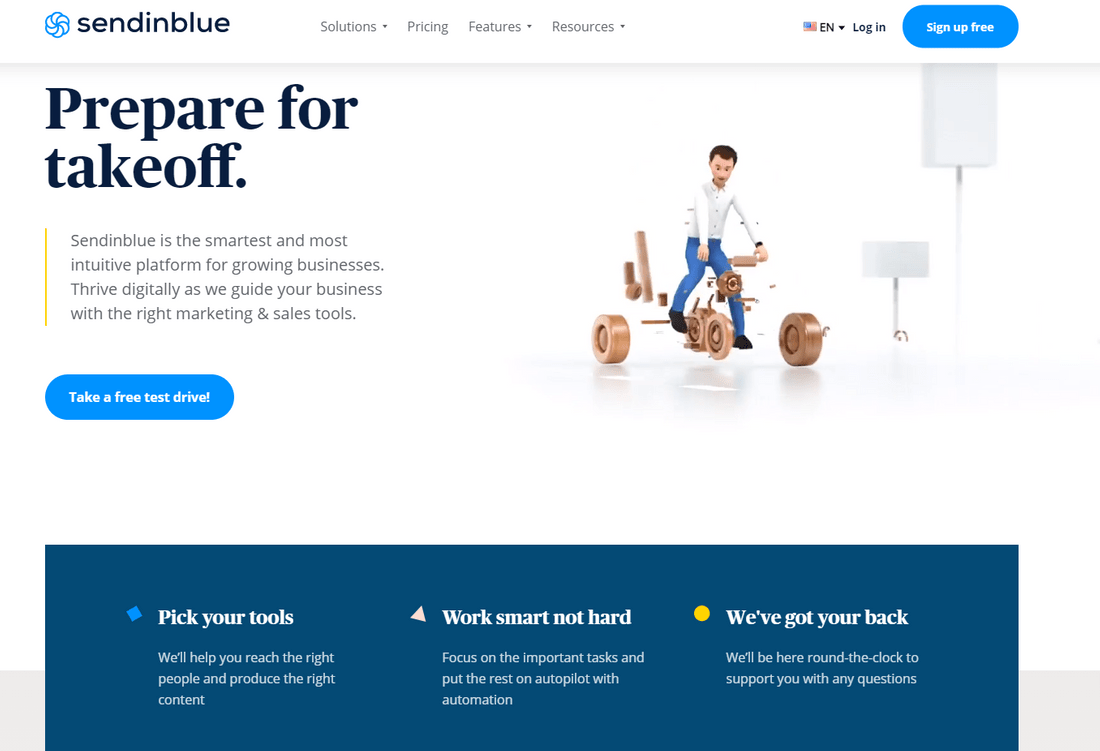How to Grow Your Business Online
If you click to purchase a product or service based on our independent recommendations and impartial reviews, we may receive a commission. Learn more
Do you want to grow your business online quickly, without using up all of your funds? We know that for business owners time is money, and both time and money can be hard to find when you’re launching a new project.
The good news is, we’ve got 13 affordable tips to help you grow your business, and they’re all something you can take action on today.
How to Grow Your Business Online: 13 Effective Tips
- Choose the right website builder or platform for your business website
- Design your site to serve your target audience
- Produce high quality content
- Improve your site speed
- Prioritize mobile-friendly content
- Make key information easy to find
- Invest in email marketing
- Help visitors find your site in search engines
- Start a blog
- Make the most of social media
- Launch pay-per-click advertising
- Leverage social proof
- Test, analyze, and make data-led improvements
We’ve been helping people build and grow their online presence for over 10 years – whether you already have a business site, or you’re just getting started, our main goal is to help you succeed online. So, let’s get started!
1. Choose the Right Platform for Your Business Site
The platform you build your business website on is the foundation of your online presence. If you pick a subpar platform, it’s likely you’ll start to struggle as you gain more traffic. Below, we outline how to choose a good website builder, and how to choose a good web host if you’re using WordPress. If you’re already happy with your platform, feel free to skip to step two!
Website Builders
We’ve tested over 50 website builders (so far), so we know what to look for – and which red flags to avoid! Here are the basics to look for when choosing a good website builder:
- Plenty of storage space and bandwidth
- No adverts on your site
- High quality template designs
- Free SSL included on all plans
- SEO tools included on all plans
- Marketing tools, such as newsletter templates
- Ecommerce options if you need to sell online
When we spoke to small business owners, they told us that SEO, ease of use, and quality features were most important to them. With that in mind, which website builder do we recommend most for small businesses?
We Recommend: Wix
Pros
- Extremely easy to use – this makes it quick to build with, even for users with no tech skills
- Awesome SEO support – Wix has an SEO Wiz tool that creates a custom action plan for you to follow
- Hundreds of professional designs – Wix has over 800 templates covering tons of industries
Cons
- Prices are quite expensive – Wix’s cheapest plan costs $17 per month
- Apps can cost extra – you’ll need to set some money aside to pay for apps. While some are free, many come at an extra cost
- Load speeds aren’t always the fastest – website loading speeds are crucial for success, and Wix doesn’t always meet our expectations
Related Reading
WordPress
To run a successful WordPress site, you need good web hosting. If you’re already signed on with a poor web host, now is the time to switch before you start trying to grow your business!
Here are the basics to look for in a good WordPress hosting provider:
- Automatic WordPress installation (or free WordPress migration if you’re switching hosts)
- Automatic WordPress updates
- Expert in-house WordPress support
- Minimum 50GB SSD storage
- Unlimited or unmetered bandwidth
- Automated backups
- Free domain name
- Free SSL included on all plans
- 99.98% uptime guarantee or more
We’ve spent over 230 hours researching the best web hosts on the market, so we can confidently recommend Bluehost as the best web host for small businesses.
We Recommend: Bluehost
Pros
- Best WordPress hosting available – Bluehost has outstanding WordPress features and even comes with a recommendation from WordPress itself!
- 99.98% uptime guarantee – this means your business site should only be down for less than two hours per year
- Affordable pricing plans – in our research we found that Bluehost’s plans offer great value, and new users get discounts for their first term
Cons
- Low storage on cheapest plans – Bluehost’s entry plans can be a bit stingy with their storage amounts, which growing businesses may find limiting
- Chance of CPU throttling – this may pose a problem for business sites that frequently experience surges in traffic
- No cloud hosting plans – if you’re after super flexible cloud hosting, where you can customize your plan for dips or spikes in traffic, Bluehost isn’t for you
Related Reading
2 2. Design Your Site to Serve Your Target Audience
Did you know it takes just 50 milliseconds for visitors to judge your website? Web design is crucial for making a good first impression – you need to convince users in half a second that your site is trustworthy, professional, and worth their time.
The secret to good web design is pretty simple: always remember who you’re designing for. Keep your target audience in mind when designing your website, and you’ll create a much better user experience. (Learn more about what a target audience is in our full guide if you haven’t got to grips with this stage yet!)
Web design isn’t just about looking good – it can boost conversions, reduce bounce rate, and is even set to become a Google ranking factor this year.
If your current business website isn’t serving your visitors’ needs, it’s time for a redesign! Trust us, it’ll be worth it – unfold the sections below for three top design tips, or read on for some useful tool recommendations.
The best place to start when picking your color scheme is with your core brand values and understanding your target audience. Do you want to inspire trust? (Use blue!) Convey a sense of fun? (Use orange!) Or create an exciting, vibrant atmosphere? (Use red!)
Different colors have different meanings, and different emotional impacts on visitors, so be careful to pick one that supports your brand personality.
Using the wrong font for your brand is jarring for the user, and sends a confusing message about what your business is all about – this won’t help you gain new clients or grow your profits!
Like colors, fonts have their own personalities and send different signals to readers, so find one that matches your brand identity.
Readability is another important factor. If visitors can’t quickly and easily find the information they’re looking for, they will leave and go to a competitor site instead. Fonts really do have an impact on user experience, so it’s worth getting right!
[caption id="attachment_47858" align="aligncenter" width="1100"] Your font can say a lot about your brand – or cause a lot of confusion. Would you hire a clown from a company that has its website written in what seems to be a blood-effect font? Whether it was intentional or the paint has dripped, the result is extremely jarring![/caption]
Your font can say a lot about your brand – or cause a lot of confusion. Would you hire a clown from a company that has its website written in what seems to be a blood-effect font? Whether it was intentional or the paint has dripped, the result is extremely jarring![/caption]
- Use plenty of headings to break up text
- Have your logo in the site header to help users get back to the homepage
- Place a call to action on your homepage
- Make your menu easy to find – the top left or right corner is best
- Place a link back to your homepage on any 404 pages
Useful Tools for Designing Your Site
- Coolors.co: free – color scheme generator
- Color Safe: free – browse colors to find the perfect shade
- CheckMyColours: free – make sure your foreground and background colors have enough contrast for those with visual impairments
- Google Fonts: free – huge library of free, open source fonts
- Tailor Brands: free to use, $9.99 to download your logo – design assisted, personalized logo generator
- Wix Logo Maker: free to use, pay $20 for commercial use – you’ll need a free Wix account to use this easy, design assisted logo maker
3. Produce High Quality Content
Whether you’re running a blog, a Twitter account, or writing an About Us page, it’s important to create high quality content for your online readers.
Writing for the web is very different to writing offline – people have shorter attention spans, and often skim the page rather than reading every word. It’s important to be engaging, and to deliver information quickly. Keep your content simple, concise, and digestible. Avoid large chunks of text, don’t use jargon, and steer clear of long, complex sentences.
We have a full guide on writing for the web – here’s a summary of the 19 top tips for writing better online content:
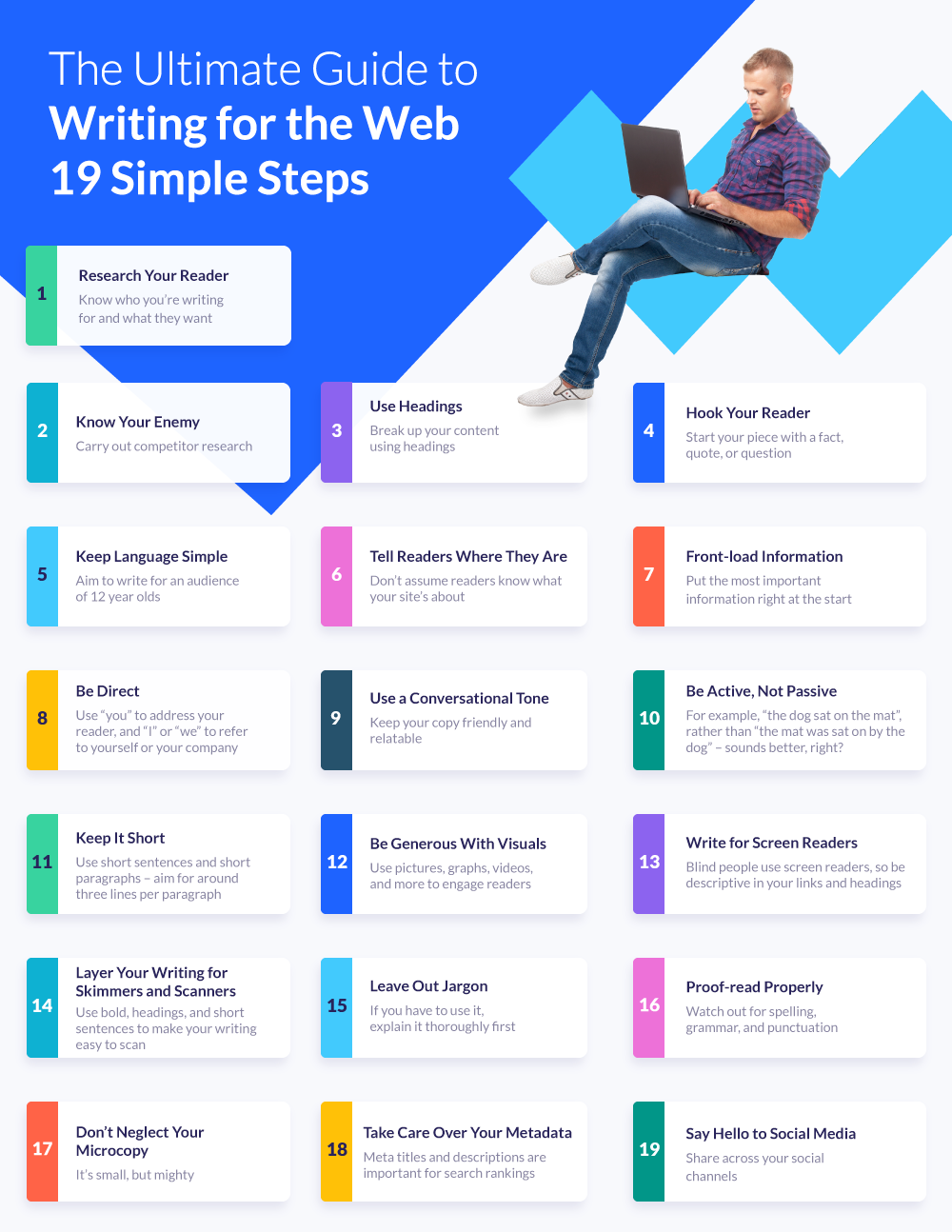
Bonus Tip: Get Persuasive!
You can use persuasive writing techniques to influence your readers. Examples of these techniques include:
- Focus on the benefits to the user rather than on features
- Use power words, (easy, free, exclusive) but use them wisely
- Be direct – talk directly to your readers
- Engage readers by using questions, repetition, and interesting facts or quotes
- Address your reader’s pain points – this is where understanding your audience can take your content to the next level!
Remember that creating high quality content isn’t always about writing. You should also make use of images, videos, and infographics to keep readers engaged and to bring extra value to your content.
Useful Tools for Creating High Quality Content
- OptinMonster’s list of 700+ Power Words: free – this is an awesome resource which lists over 700 power words, split into categories, and with examples to guide you on their use
- Hemingway App: free – this app grades and analyzes your copy for readability, such as highlighting any sentences that need shortening
- Grammarly: free – this tools helps you avoid embarrassing spelling mistakes by analyzing your content for grammar issues and readability
- Canva: free – an easy to use graphic design platform where you can create infographics, posters, social media posts, and videos
- Upwork: paid – if you don’t want to write your own content, you can hire someone else to do it through a “work marketplace” such as Upwork
4. Improve Your Website Loading Speed
How quickly your website loads will have a huge impact on how many people stay and come back to your website. One in four visitors would abandon a site that takes more than four seconds to load, and 46% of users don’t return to websites with poor performance.
In short, people are impatient, and if your site is too slow then you’ll struggle to grow!
Test how good your page load speeds are right now using a free online tool such as Pingdom – you simply enter your URL to run a website speed test and identify weak areas. Ideally, your site should no longer than two seconds to load. If you run your site through Google PageSpeed Insights, you should aim for a score above 90.
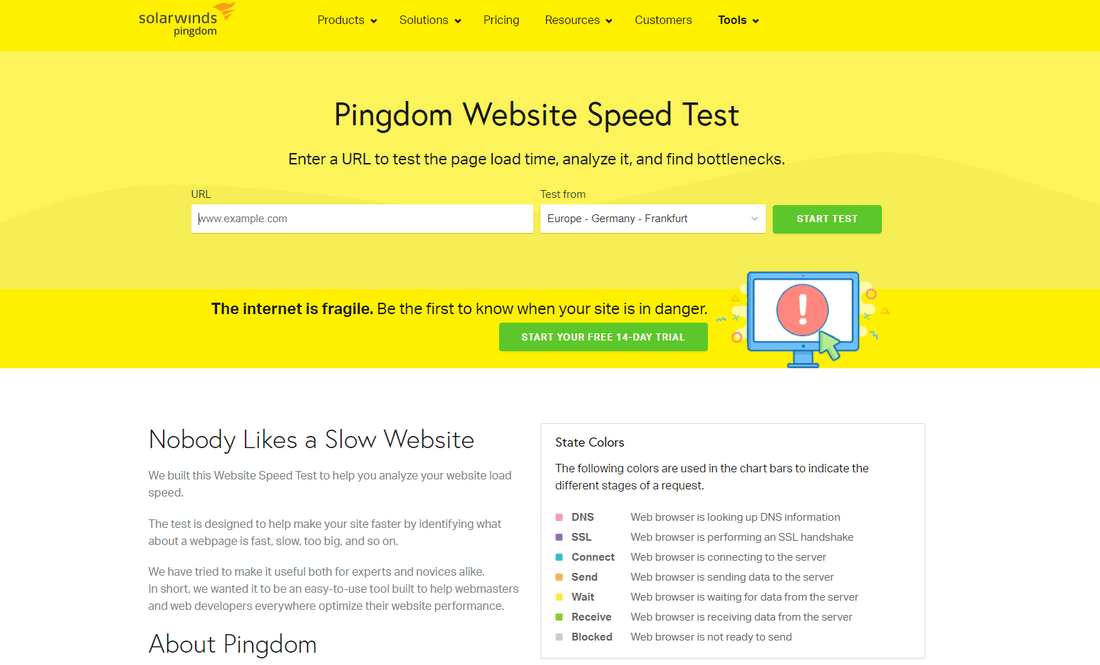
Even if your results are good, you should still look for ways to improve – even a 0.1 second improvement can increase order value by 9.2%! Here are a few ways you can speed things up:
- Check your hosting plan – if your site is lagging or crashing, you may need to upgrade your hosting plan, or change the type of hosting you’re using. You might even need to switch providers entirely if its servers keep going down!
- Compress your images, videos, and files – the more files you have, and the bigger those files are, the slower your site will be. Compression reduces the file size and helps your site load faster.
- Assess your plugins – too many plugins will slow your site down, and chances are you have more than you need. Could it be time for a clear out?
- Use a CDN – this spreads bandwidth across multiple servers, and is a much speedire option than relying on a single server to deliver your content to visitors.
Useful Tools for Improving Site Speed
- Pingdom: free – see how fast your site is and get a custom analysis
- Google PageSpeed Insights: free – enter your URL for a free analysis and suggestions on how to improve your page speed
- Kraken.io: free – easily compress images to upload to your site
- HTMLMinifier: free – a tool for compressing HTML code
- CSSNano: free – a tool for compressing CSS code
- UglifyJS: free – a tool for compressing JavaScript
- Bluehost: $2.95+ per month – a web host with 99.98% uptime that provides free CDN
- Cloudflare: free – a popular CDN provider
Related Reading
- Website Load Time Statistics: explore the importance of site speed and what you can do to speed up your site
- Website Builders and Core Web Vitals Insights: discover what the impact of the Core Web Vitals update is, and how to improve your site’s performance
5. Prioritize Mobile-Friendly Content
Many businesses leave their mobile site as an afterthought, and it shows in the user experience. That’s a problem when mobile ecommerce traffic grew by 25% in Q1 2020, and when you consider that mobile traffic accounted for 54% of internet traffic in February 2021.
Instead, you should design your mobile content as a priority – this will result in a smoother, more enjoyable experience for mobile users. It also has a huge impact on your rankings, as Google only indexes your mobile site, rather than your desktop site. That means both versions will suffer if your mobile site isn’t up to scratch.
Here are five ways you can make your mobile content more user-friendly:
- Strip your content back to basics – avoid large chunks of text!
- Remove unnecessary content such as adverts that can look cluttered
- Make buttons large and easy to tap with a thumb or finger
- Use plenty of white space
- Think about what the user wants, and give it to them straight away – don’t make them scroll for it!

Useful Tools for Creating a Mobile-Friendly Business Site
- Google’s Mobile-Friendly Test: free – type in your site’s URL and Google’s tool will tell you if your site is mobile-friendly or not!
- AMP: free – Accelerated Mobile Pages helps pages load faster on mobile devices
- Bootstrap: free – a front-end framework that scales your webpage to fit different devices (you’ll need coding knowledge for this!)
- Mobile-responsive website builder or WordPress themes: free and paid available – in these cases, your content automatically adjusts depending on the device being used
Related Reading
6. Make Key Information Easy to Find
Even if your business site loads super quickly and is beautifully designed, if you can’t give the user what they’re looking for quickly, they won’t hang around looking for it – they’ll go looking somewhere else.
If you want visitors to stay – and eventually convert – you need to make important information easy to find on your website:
- Contact details – 64% of users want to see a company’s contact information on the homepage
- Pricing – be transparent and upfront about your pricing
- Shipping and returns policies – two thirds of shoppers want to be clear on the return policy before buying a product online
- Your location – if you have a physical location, help people find you using maps, directions, or a photo of your premises!
To make key information really easy to find, you can list your company on Google My Business for free. This means that when someone googles your business, your listing appears telling people your location, opening hours, contact details, and website address. It means visitors don’t even have to click onto your site to get in touch or visit you in person!
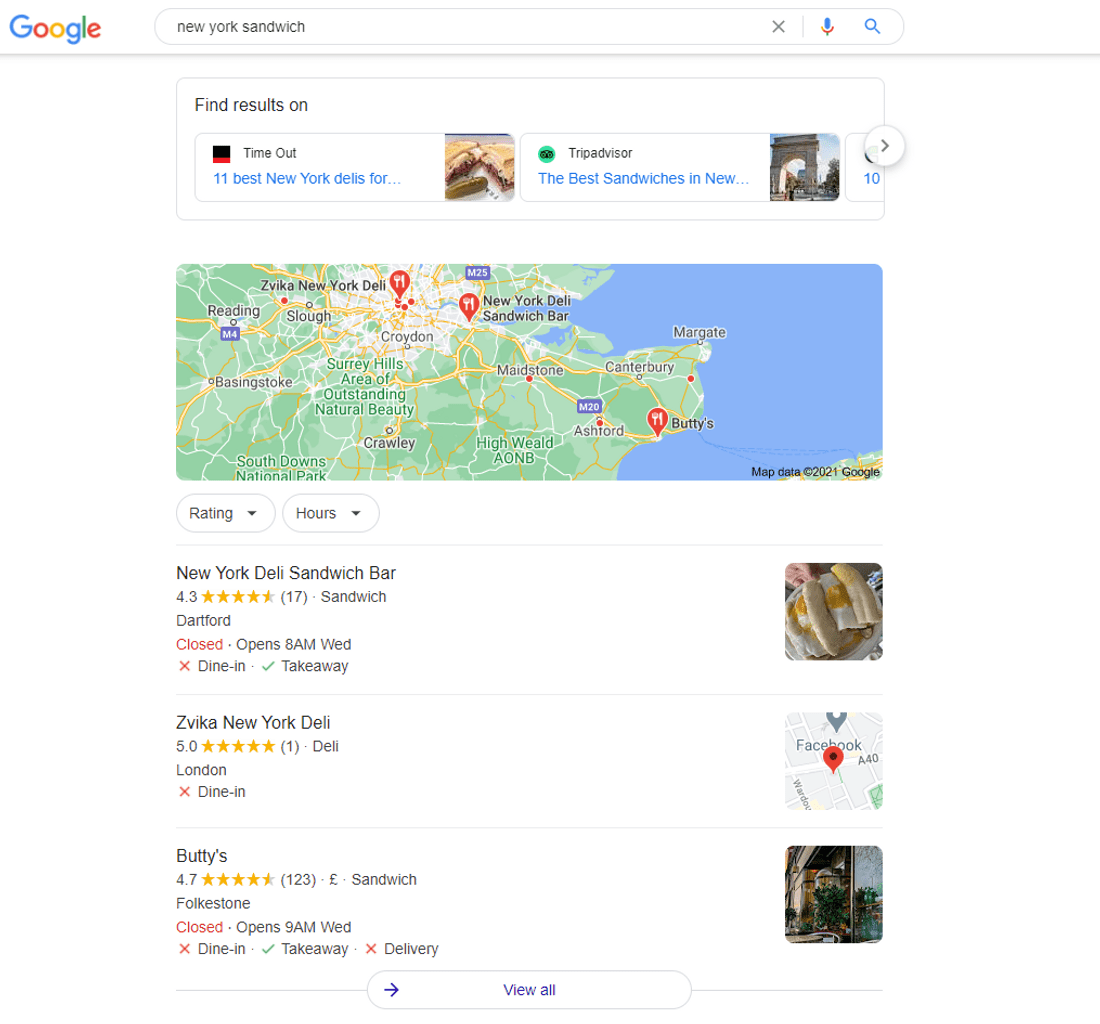
Useful Tools for Helping Users Find Key Information
- Google My Business: free – displays your business information at the top of Google search results
- WPForms: free – a contact form plugin for WordPress websites
- WP Google Maps: free – a WordPress plugin that lets you add a location map to your website
7. Invest In Email Marketing
Did you know that email marketing offers amazing return on investment? For every $1 you spend, you can expect to make back $42 on average, making email marketing a powerful tool for growing your business!
Using an email marketing tool makes it easy to stay in touch with your visitors and keep them engaged with your business. You can send newsletters, promote sales, ask for testimonials or product reviews, conduct surveys, share important updates, and more.
We’ve spent over 160 hours testing email marketing platforms, so we can recommend the best email marketing service for you – in our research, we found that Brevo (formerly Sendinblue) is the best email marketing for small businesses.
We Recommend: Brevo (formerly Sendinblue)
Pros
- Best value for money out of all other small business email marketing software that we tested
- Easy to use – the email editor is intuitive and the setup process is logically laid out, making it quick and simple to get started
- Powerful features – for example, automation is a priority, saving time for busy business owners!
Cons
- Template designs are pretty average – they won’t knock your socks off, so if you’re looking for groundbreaking design then this service isn’t right for you
- Servers can be slow – this was one of our biggest concerns during testing, as slow server times may prove frustrating for business owners during day-to-day use
- Automation tools come with a learning curve – set some time aside to learn your way around its automation tools
“It was very good at following my train of thought when composing an email and getting it ready to send. I would get to a point where I needed to add contacts to my database, and there was a next step suggestion regarding this very topic.”
Useful Email Marketing Tools
- Brevo: free – our top-rated email marketing software for small businesses
8. Help Visitors Find Your Site In Search Engines
Perhaps you already have email marketing set up, and your business site primed and ready to go. But what if nobody is seeing it? If low traffic is your problem, you need to spend some time on your website’s Search Engine Optimization (SEO).
SEO is the art of getting your website to rank higher up in search results – considering only 0.44% of Google users visit the second page, being on the first page of Google is vital for people finding your website.
There are over 200 factors that Google takes into account when ranking websites, so we could go on and on about the many ways to improve your rankings. Some factors we’ve already covered in this list, such as site speed, high quality content, and mobile experience.
We’ve picked out three SEO tactics to get started with today. Unfold the section below to read about each one:
Use online tools such as UberSuggest to see which search terms have good search volume (how many people are googling certain keywords) and how “difficult” or competitive they are to target.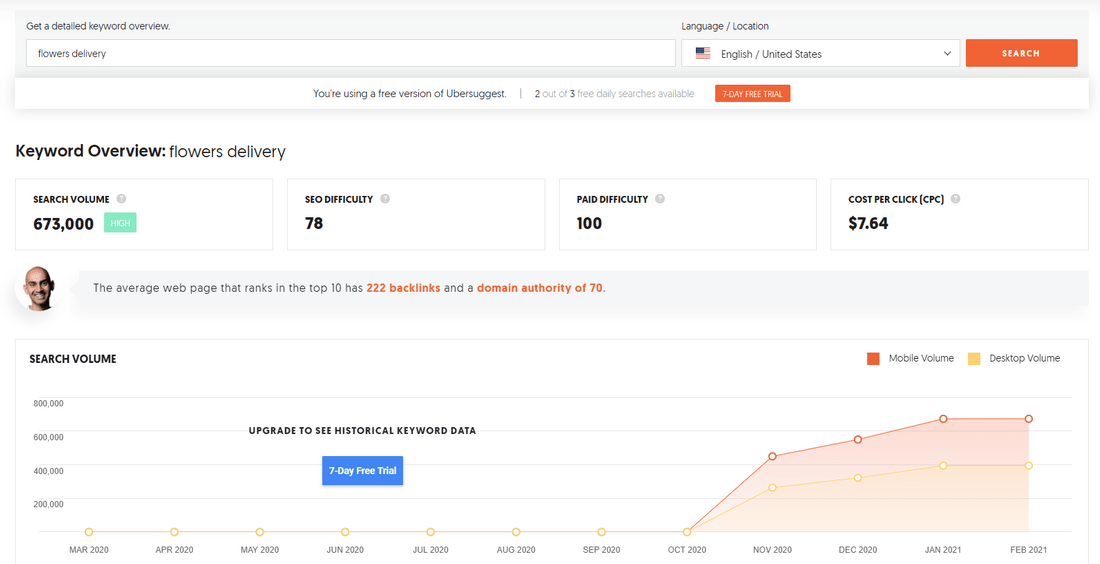
The golden balance is finding keywords that have great search volume but not much competition – this is very rare, so don’t worry too much if most of your search terms seem targeted by your competitors already.
Once you’ve found a keyword you want to target, create some high quality content around it. Be sure to use the keyword in your headings and metadata, and regularly throughout your content. You’ll get the best results when you can show your site has strong expertise in one area, so try not to jump around too much!
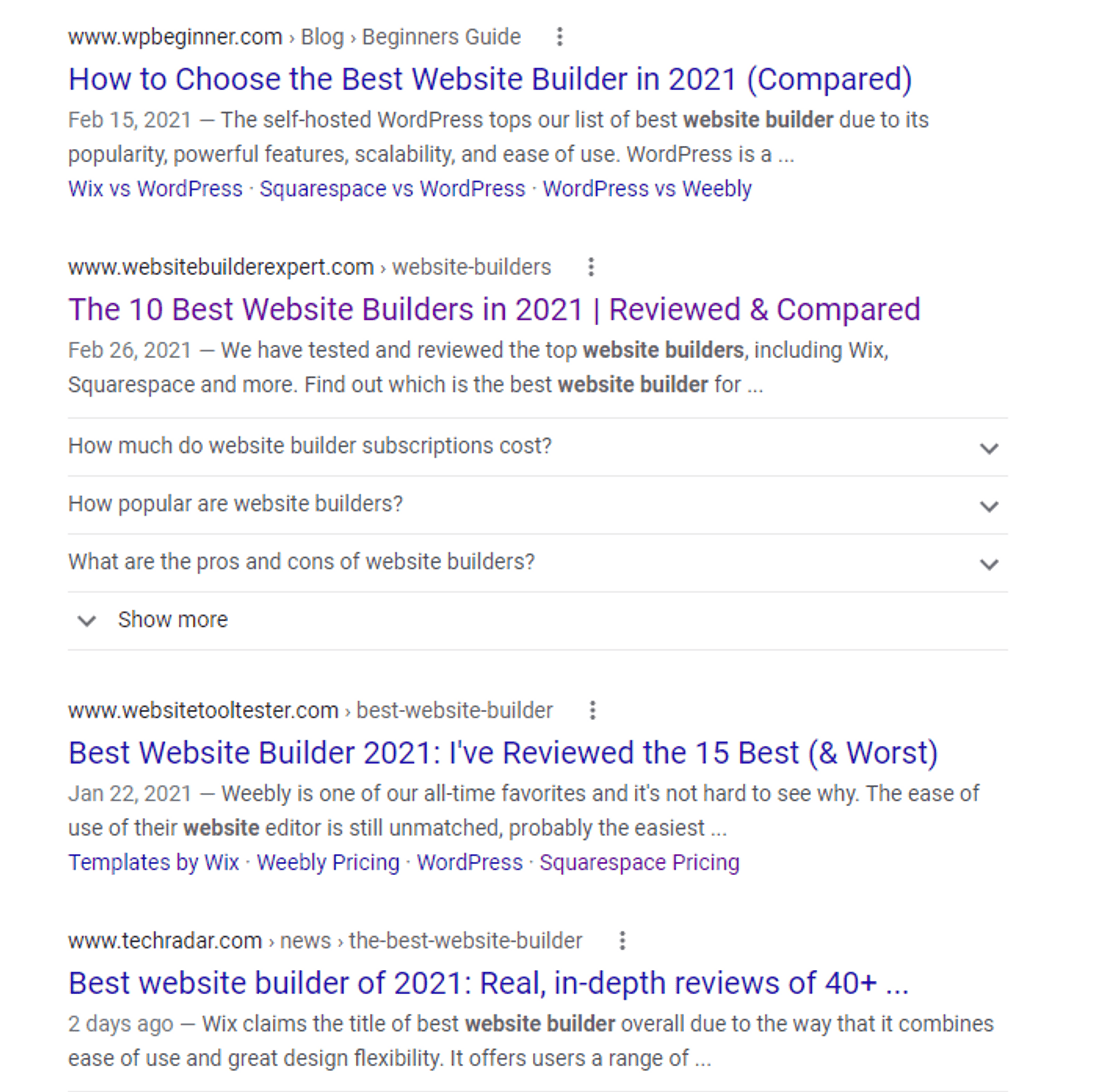
The blue links are called meta titles, and the short snippet of text underneath is called a meta description. You can edit these yourself to make them more attractive to Google – make sure they contain your target keywords!
Here are some top tips for writing better meta titles and descriptions:
- Keep it short! If your metadata is too long, Google will simply cut it off, so keep it snappy
- Put the month or year in your meta title. This shows Google and users that your content is fresh
- Place your main keyword in the first half of your meta title
- Be specific. In the meta description, tell users exactly what to expect from your page – remember they’re trying to find relevant information as fast as possible
- Use persuasive language. The more people who click on your result, the better! You need to make your search result seem like the most useful, inviting page to click on. The more people who click on your result, the more Google will prioritize it in rankings.
This is why it’s important to have good links set up between your pages, and to avoid broken links at all costs!
Avoid linking externally to sketchy or low quality websites as well – Googlebots follow these links and associate you with the sites you link to.
Useful SEO Tools
- Yoast SEO: free – a popular WordPress plugin designed to help manage your site’s SEO
- Semrush: $119.95+ per month – an all-in-one suite for SEO, especially useful for carrying out keyword research
- Ahrefs: $99+ per month – a keyword research tool that has a neat keyword explorer feature if you need keyword suggestions
- Google Keyword Planner: free – designed for running Google ads, but is a useful free tool for general keyword research too (you’ll need a free Google Ads account)
- AnswerThePublic: free – an easy to use tool that shows you useful phrases and questions people are searching for around your keywords
- UberSuggest: free – another easy to use tool that gives you a helpful “Keyword Overview” including search volume, SEO difficulty, and keyword suggestions
9. Start a Blog
Okay, so you shouldn’t start a blog just for the sake of it. However, blogs are great for engaging visitors and keeping them interested over time. It also offers more opportunity to rank for different keywords and gain more traffic.
Here are six top tips for running a blog for your business:
- Make sure that your blog covers topics relevant to your business
- Plan ahead so you can post new articles regularly
- Make use of events – such as Black Friday – to post topical content
- Write guest posts for other blogs
- Share your blog posts on social media to promote your blog
- Send newsletter updates via email marketing
Useful Blogging Tools
- BuzzSumo: $99+ per month – a useful tool for content research that helps you find discover trending stories
- CoSchedule: $29+ per month – a handy marketing calendar that helps you schedule and manage posts, and share them to social media
- Trello: free – a card-based management system to track and organize projects
- Google Trends: free – search for your topic to see if it’s trending in Google
- WordPress Distraction Free Writing: free – WordPress users may benefit from Distraction Free Writing mode, which you can turn on inside your editor using the “Toggle Full Screen” button in your toolbar
- Unsplash: free – blog posts need images, and Unsplash is an awesome library full of free photos
10. Make the Most of Social Media
Social media is one of the best free advertising opportunities for growing businesses. It offers a huge opportunity for engaging with a wide audience – in 2020, over 3.6 billion people were using social media worldwide.
Facebook is still the most popular social media platform in the world, with approximately 2.5 billion monthly users. This said, it’s important to choose the right social media platform for your business.
For example, a recruitment agency is likely to benefit from an active presence on LinkedIn, whereas a photography studio would be better suited to Instagram. Think about your target audience and which platforms they’re most active on.
Here are 10 tips for making the most of social media to grow a following:
- Be selective about which platforms you share on. Don’t try to spread yourself across all of them – target the right audience for your business.
- Post regularly. Sporadic sharing is a big no-no – don’t post five items in one day and then go silent for a month.
- Share relevant, high quality content. Don’t share stuff just for the sake of it – make sure you have something to say that will be of value to your audience.
- Use a consistent tone of voice. Always make sure your social presence stays true to your brand, otherwise mixed messaging will confuse your audience.
- Engage with your followers! Reply to followers, answer questions, set up polls or competitions, share their posts when they feature your business, and so on.
- Think before you post. Social media is usually a more informal setting, but remember that you’re a business. Think about the language you’re using, don’t get drawn into arguments, and always check hashtags and spelling before sharing!
- Optimize your send times. What times are your audience most likely to see and engage with your post? Remember to cater to time zones too.
- Share images and other media. People respond positively to graphics and images on social media, so sharing visuals may help boost your engagement.
- Don’t be too salesly. People generally use social media to relax and be entertained, so don’t be too salesy – mix it up!
- Make your content shareable. Include quotes, statistics, and advice in your blog posts that people may want to share. Make sure to include social icons to make it easy for people to follow or share!
Useful Social Media Tools
- Hootsuite: $49+ per month – schedule posts in advance and measure engagement using analytics
- ClickToTweet: free – make it easy for visitors to share your content with premade Tweets embedded in your content
- Bitly: free – a neat tool for shortening links
- Venngage: free – easily create infographics to make your social content more engaging
Related Reading
11. Launch Pay-Per-Click Advertising
Pay-Per-Click (PPC) advertising is where you bid on target keywords to appear in search engine results, to encourage users to click on your website. These paid adverts usually appear at the very top of the search results:
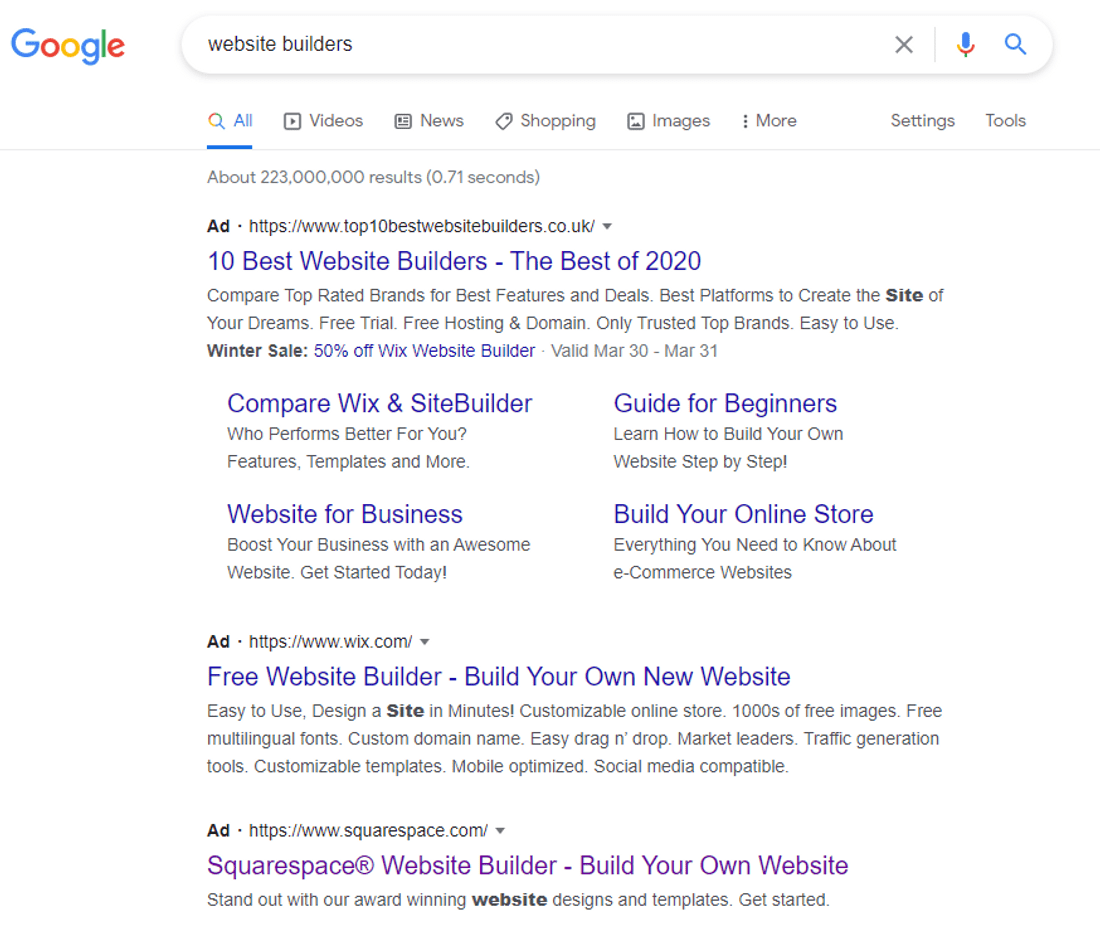
The benefits of paid advertising include driving more traffic and conversions, targeting your audience, and access to more data so you can analyse and improve your campaigns.
One of the biggest pros of PPC is that it’s a really quick way to see results. It’s ideal for quickly growing your traffic and conversions, because it immediately gives you greater visibility in the search results.
However, it can be costly, and as soon as you stop paying your visibility disappears completely. Luckily, there are affordable ways to run PPC campaigns.
Popular methods include Google AdWords and Facebook Ads, and we recommend these because they give you plenty of control, are easy to get started with, and help you target your specific audience.
You’re in control of how much you want to spend and which keywords you want to target, which should help you stick to a budget.
Useful Tools for Launching Pay-Per-Click Advertising
- Google AdWords: free to create an account, set your own campaign budget – bid on target keywords, then pay for clicks via the ad to your site
- Facebook Ads: free to create an account, set your own campaign budget – create and manage Facebook advertising campaigns
12. Leverage Social Proof
Don’t underestimate the immense power of social proof – a huge 87% of consumers read online reviews for local businesses in 2020. People rely on social proof to decide whether to trust a business, buy products, or choose one service over another. Some social proof examples include customer reviews, user-generated content, and press coverage.
92% of consumers are less likely to use a business because of negative reviews, so if you get a lot of complaints it’s time to make a change. An average Google My Business listing is viewed 1,260 times per month, so don’t think nobody will notice a low star rating!
Here are four easy ways to leverage social proof to grow your business online:
- Set up a Google My Business listing. Set up a new Google Account and click ‘Manage Now’ on the Google My Business page. Enter your business name, location, business category, contact details, and your website URL. You can then finish the setup and verify your business. After that, you can add photos, write a business description, and more to make your listing as appealing and informative as possible!
- Gather customer reviews and testimonials. Put positive quotes and testimonials on your homepage and share them on social media – you could even create a dedicated “case studies” page on your website.
- Reply to reviews and comments. 78% of consumers said that a business responding to reviews was important to them. It’s also a great chance to salvage negative reviews, by actively helping customers sort out any issues.
- Display star ratings where possible. Star ratings are the most important review factor. Only 48% of consumers would consider using a business with fewer than four stars, so every rating counts!
Useful Tools for Leveraging Social Proof
- TrustPulse: free – automate social proof, show real-time customer activity to other visitors via popups, and integrate with hundreds of other platforms
- Proven: $39+ – a WordPress plugin that shows social proof notifications to visitors, so you can showcase recent sales, newsletter signups, and so on
- Proof: $26+ per month – customize social proof notification and collect useful data
- WP Customer Reviews: free – a WordPress plugin that makes it easy to collect customer reviews through your website
Related Reading
13. Test, Analyze, and Make Data-Led Improvements
The joy of running a growing business is that you’re never finished. As soon as you think “Yes! I’m seeing results!” is the time to think “What next?”. Growing your business is all about trying out new tactics, measuring the results, and making decisions based on the data you see.
We recommend trying any of the tips we’ve talked about in this list and measuring the results. But there are also much smaller details that you can test, which can have a huge impact. These include:
- Call to action colors and styles – simply changing the color of a button can have a huge impact on conversions!
- Email subject line, send time, and content variations – Sendinblue allows all three
- Headings – do your readers respond better to questions, controversy, or teasing hooks?
- Social media posting times – does morning, lunch, or evening yield better results?
- Email sign-up wording – include how many people have already signed up, for example
- Popups – size, color, and timing, such as entry popups versus exit popups
At the end of the day, you’re the best person to know which tests you should run. Understanding your audience and which metrics are most important to you will have a big influence on which factors you’ll test going forwards.
Useful Tools for Testing and Improving Your Business Site
- OptinMonster: $14+ per month – lead generation software that lets you create and test email signup forms
- CrazyEgg: $294 per month – useful eye-tracking data such as heat maps and scroll maps that show you how people are interacting with your site
- Google Analytics: free – provides valuable data about your website traffic, bounce rate, conversions, and more, so you can track performance
- Optimizely: custom pricing – easily carry out A/B testing to see which version visitors respond to best, helping you optimize your site
- HubSpot: free version available – an all-in-one platform that combines marketing, sales, and customer service, useful for managing everything in one place
How to Grow Your Business Online: Summary
This article has explored 13 ways you can grow your business online – we want you to succeed, which is why these tips don’t require any special skills, and can be actioned today!
Whether you’ve just launched a brand new business, or you’re looking to take your current small business to the next level, these tips will set you on the right path. We listed useful tools for each one – you can usually find good quality, free tools to support you, so don’t worry if you’re on a tight budget.
Let’s have a final recap of each step:
- Choose the right platform for your business website
- Design your site to serve your target audience
- Produce high quality content
- Improve your site speed
- Prioritize mobile-friendly content
- Make key information easy to find
- Invest in email marketing
- Help visitors find your site in search engines
- Start a blog
- Make the most of social media
- Launch pay-per-click advertising
- Leverage social proof
- Test, analyze, and make data-led improvements
Which one will you get started with today? We’d love to know, so drop us a comment below with your thoughts!

